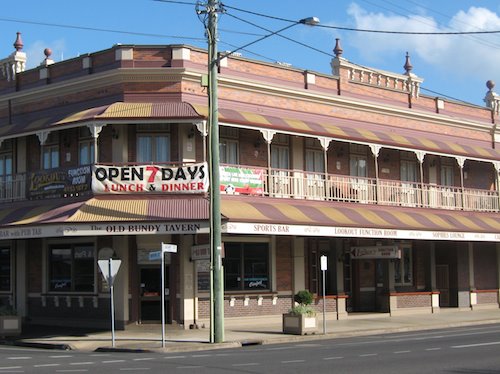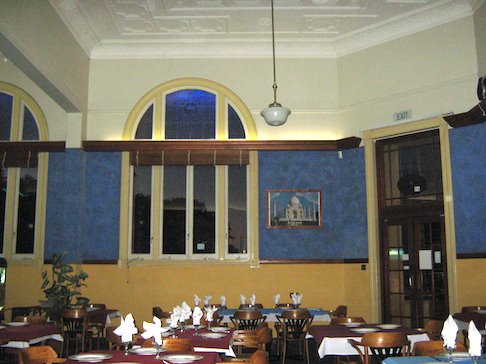We were anchored in what was technically Bundaberg Port rather than in the town itself, which is a few miles upstream. It is theoretically possible to take a keel boat all the way up to Bundaberg itself, but there was a shallow section that would only be passable on a good tide and we were happy where we were, so we unlimbered the tender and prepared ourselves for a little expedition.
This whole outboard motor thing is still new to us, so we didn’t know how long it would take us to motor the six miles into town and back, with or against the tides and with or against the prevailing winds. We packed a variety of clothes and some spare fuel, and set off.
The river is very wide and, as we found when I flamboyantly decided to cut a corner, quite shallow enough in places to beach an eight-foot dinghy. One bank seems to be mainly mangroves, while the other is taken up with a sugar cane plantation. A little way along, we chugged past what is presumably the cane farmer’s house, very nice indeed with a large ketch moored at the bottom of the garden.
This was the only boat that we saw on the river, and we were once again surprised at how quiet it is here. We have come to expect that waterways are always packed with fishermen in tinnies and people in runabouts, but there had been nothing moving at the port and there was nobody around here. Only when we reached the outskirts of the town did we see one or two men with rods standing on the shore.
Mind you, we were grateful for the peace. The headwind was opposing the incoming tide and we had to contend with some pretty large waves without the additional excitement from the wakes of full-bore fishing tinnies.
It’s almost six miles from the Cane Ferry to Bundaberg, and we discovered that the Walker Bay with its 3hp outboard will run for five miles before it runs out of fuel. The whole journey took about an hour an a half. So now we know.
Bundaberg itself was small and compact, and contained the kinds of stores that suggested that people come in from the country to get supplies. The most interesting architecture was (as usual) to be seen in the pubs, which stood on every corner.

THE OLD BUNDY TAVERN. PERHAPS WE SHOULD HAVE DRUNK HERE INSTEAD?
Since we were standing at the centre of the mighty Bundaberg rum empire, I expected to see a great many rum-related motifs and interesting rum products for sale, but this wasn’t the case at all. Even the pubs didn’t carry anything more elaborate than the usual Bundy-and-coke in a can.
We had intended to visit the distillery, but by the time we got there it had closed for the day. We had heard, though, that the tasting room does not present the usual display of grand old vintages that you might expect, but instead focusses on all the different mixers that you can put into your Bundy to make it taste better. This seems reasonable to me, because – grand old Australian institution as it may be – it does taste pretty nasty on its own.
We had with us a fairly esoteric shopping list, but the town managed to come up trumps with the whole thing; Croc boat shoes, a circuit breaker, a European pillow case, an adjustable wrench, a computer fan and a cribbage board. We even found somebody to make us a three metre steel leash for the tender.
Spotting an Indian restaurant, we decided to splash out on a celebratory meal. It wasn’t open yet, so we waited over indifferent beer outside an indifferent pub, counting the teenage mothers as they strutted past in the gathering dusk.
The restaurant itself occupied a fine old corner building, possibly an old bank or post office, and had been rather lovingly restored with hardwood dado rails and original brass electrical fittings overlain by the usual Indian restaurant colour scheme but executed with rather more taste than usual. We asked for the wine list but they turned out to be BYO, so Bronwyn popped out to find some wine while I ordered a vindaloo and a jalfrezi.

INSIDE ‘SPICES PLUS’ RESTAURANT
Some time later, Bronwyn had still not returned. I drank my third glass of water and grinned helplessly at the waitress who was hovering uncertainly in the wings. Another two couples arrived and ordered, and then finally the door opened and Bronwyn arrived triumphantly brandishing a bottle of white. There were, it seems, only two places in town where you could buy wine. The RSL wouldn’t serve her unless she was a member, and she couldn’t become a member without a driving licence, although they were happy for her to drink at the bar. The off-sales counter at the neighbouring pub was happy to sell her a bottle until they discovered that they had run out of brown paper bags. Apparently this was a big deal, because they refused to sell her wine without a bag. Eventually they came to an agreement where she paid the more expensive pub price, and then they “forgot” to open it and Bronwyn smuggled it out under her jacket. I’m sure that there is some logic in that somewhere.
Finally we were all set to enjoy our meal. I had deliberately ordered both dishes “hot” because the Australian taste is for very bland food and we fancied a bit of spice. In the event, I suspect that the chef merely wafted a couple of chillies over the pan before putting them away for the next mad Englishman, because even the vindaloo was exceptionally mild. Still, the dishes were well made and the staff friendly, and we had a lovely evening. It made a nice change for somebody else to do the cooking and the washing up.
It was full dark by the time we left the restaurant and made our way down to the river to our tender, but the river was smooth and calm and the clouds drew back to reveal a crescent moon. We motored back along past the fields of sugar cane, with the moonlight glinting off the water and the Milky Way shining above. It was absolutely glorious.